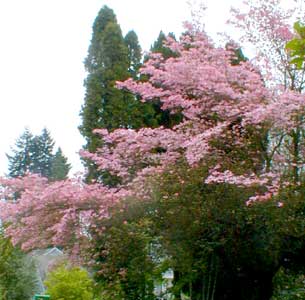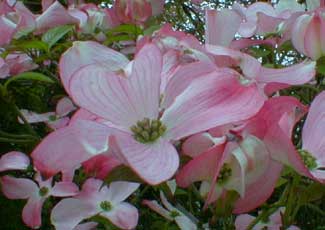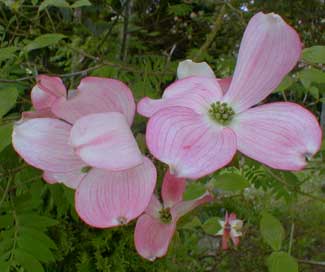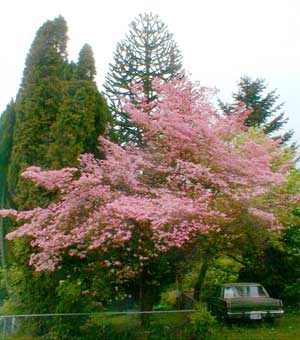
'Cherokee Chief'
Pink Flowering Dogwood
"But here in the decent quiet
Under the whispering pines,
Where the dogwood breaks in blossom
And the peaceful sunlight shines,
Where wild birds sing & ferns unfold,
When spring comes back in her green & gold."
-Bliss William Carman
(1861-1929)
(1861-1929)
There are a half-dozen pink dogwoods (Cornus florida var rubra) in our immediate neighborhood. While they were in full bloom in April, I walked down the road & took a few pictures of the largest & my favorite. Three of the four photos on this page are of that big one, but one of the two close-ups (the second photo) is from the house next door to the house with the twenty-five-foot pink dogwood.
Pink dogwoods must exist in this neighborhood at the rate of one to three per block, & that's fewer than there are of our locally native white western dogwoods (of which I can see three without turning my head while standing on the sidewalk in front of the house).
There is an old belief that dogwoods like partial shade, but the fact is, they are healthier in full sun so long as they are provided with sufficient irrigation. When grown in the sun they gain height & width more rapidly, have more leaves & many more flowers. It requires soil with good drainage but is otherwise forgiving of a wide range of soil conditions. It is not awfully heat-hardy & should not be grown above Zone 8.
 The pink dogwood's flowers of late April & early May are followed by bright red fruits in clusters. Though theoretically edible they have insufficient flavor to be harvested for human use, but squirrels & larger birds love them.
The pink dogwood's flowers of late April & early May are followed by bright red fruits in clusters. Though theoretically edible they have insufficient flavor to be harvested for human use, but squirrels & larger birds love them.The pink dogwood most commonly encountered as a mature tree in local yards is an old variety called 'Cherokee Chief' selected for the especially intense pinkness of the flower's large bracts. The "true flower" at the center of the four bracts are yellow micro-blooms, so by tradition the large bracts are regarded as flower-petals though that's botanically incorrect.
Not every neighborhood where dogwoods once grew is today so well blessed as ours. A veritable plague has been taking the lives of the American flowering dogwoods. The eastern dogwood, white form & pink form, & the white western dogwood, have been vanishing out of forests due to the fungal disease, dogwood anthracnose, caused by the organism Discula destructiva introduced into the United States sometime in the 1970s.
It arrived simultaneously in Washington state & Connecticut & began its deadly march across the continent. Though it seems probable that it came from outside the country, the origin of the organism has yet to be discovered.
For whatever lucky reason, Kitsap County has not been assailed by this disease & our substantial population of gardened C. florida & wild as well as gardened C. nuttalii have to date been spared. But anthracnose is frankly the reason I never planted a dogwood in our own gardens, as I didn't want to nurture & love a tree that is at this point in history so much at risk. Fortunately I get to enjoy them anyway, all over our own neighborhood & along every wooded road of the county.
 The best hope for the eastern dogwood are the descendants of one surviving tree after mass die-off of dogwoods in Catoctin Mountain Park in Maryland. The forest had lost ninety percent of its dogwoods by the end of the 1980s due to anthracnose. In 1990 one tree was observed to be unaffected. That tree was closely scrutinized by Professor Windham of the University of Tennessee, & a new cultivar was soon in the making, named 'Appalachian Spring.'
The best hope for the eastern dogwood are the descendants of one surviving tree after mass die-off of dogwoods in Catoctin Mountain Park in Maryland. The forest had lost ninety percent of its dogwoods by the end of the 1980s due to anthracnose. In 1990 one tree was observed to be unaffected. That tree was closely scrutinized by Professor Windham of the University of Tennessee, & a new cultivar was soon in the making, named 'Appalachian Spring.''Appalachian Spring' is a vigorous large-flowered C. florida var alba. The fate of the pink variant, long the preferred variety for gardens, is still up in the air, though hybridizing with 'Appalachian Spring' is expected in the future to confer protection from the fungus to the pink dogwood as well.
The University of Tennessee's horticultural extension & experimental station in Knoxville had the resistant dogwood under production & ready to release by 1998. In Autumn 2001, young specimens of 'Appalachian Spring' were re-introduced into the decimated Catocin forests. The long-term plan is to re-introduce the eastern dogwood into other forests where it naturally grew but has died out due to the dreaded fungus.
The experimental station is additionally using 'Appalachian Spring' to create other strains of resistant dogwoods. Furthermore, budwood has been supplied to commercial nurseries in Tennessee under special liscense. Growers outside of Tennessee are on a waitlist & when budwood comes available, there will be increasing numbers of growers & breeders. The eastern flowering dogwood would seem to be guaranteed a continuing presence among forests & gardens alike.
Hope for the western dogwood is still not very good. However, after forest fires in British Columbia in forests where the dogwoods were afflicted with anthracnose, the western dogwoods made an unexpected comeback. This feat is not yet thought indicative of lasting improvements, but it does lend some sense that Nature may provide resistant wild trees for the western species given time.
Before the development of 'Appalachian Spring,' there were other attempts to develop hybridized pink dogwoods, crossed with the Korean C. kousa which was less effected by the disease. Cornell University & Rutgers University developed & distributed the "Stellar series" of resistant hybrids, namely 'Aurora,' 'Celestial,' 'Constellation,' 'Ruth Ellen,' 'Stardust,' & 'Stellar Pink.' They were initially bred for the impact of the pink flowers, but turned out to have some degree of both mildew & anthracnose resistance. Still, & alas, as young trees most of them have been found to be a little less resistant than would be optimal.
Unfortunately, a mutated strain of the deadly fungus has begun to infect C. kousa, & if that spreads too, Korean dogwoods will no longer provide an easy option for dogwood lovers. And some of the hybridized C. florida x kousa may cease to be resistant .
It has been increasingly necessary to identify specific C. kousas that are resistant rather than assume all are. Among those reported to be resistant (as of this writing) are the Korean dogwood cultivars 'Steeple,' 'Stardust,' 'Stellar Pink,' and 'Galaxy.' Intermfediate in resistance are 'Milky Way Select,' 'Gay Head,' 'Constellation,' 'Julian,' 'Temple Jewel,' 'Elizabeth Lustgarden,' 'Big Apple,' 'Aurora,' 'China Girl,' 'Ruth Allen,' and 'Greensleeves' [Ranney et al, Journal of Arborculture 21, 1995].
CARE OF AN AFFLICTED DOGWOOD:
 There is no cure or effective treatment for dogwood anthracnose. Dogwoods may look very nice in alternating years, giving a gardener who loves her tree the wild hope that the tree is recovering. But seeming improvement in a given year is invariably an illusion.
There is no cure or effective treatment for dogwood anthracnose. Dogwoods may look very nice in alternating years, giving a gardener who loves her tree the wild hope that the tree is recovering. But seeming improvement in a given year is invariably an illusion. Even so, infected trees given ideal care are stronger at fighting off the cyclic attacks this disease makes on the trees, which is worse in years with heaviest rainfall. These are the efforts that will have some positive effect on the infected tree:
- Careful watering during droughty months.
- Perfect drainage during rainy seasons.
- Mulching to limit its watering needs, starting one foot away from trunk extending to drip line or further.
- Avoiding overhead watering & whatever else it takes to keep the leaves dry more often than wet.
- Protection from bark impacts or injuries
- Maximizing air circulation around the tree by having no other trees nearby.
- Persistent removal & careful discarding of limbs & twigs showing signs of infection.
- Persistent removal & careful discarding of fallen leaves.
- Avoidance of fertilizers, or if used at all, lowest-nitrogen fertilizer once a year only, in spring. Sterile manure compost would be better.
- Locate tree in sun. Despite that younger dogwoods in particular like shade, alas so does the anthracnose, & the tree will adapt to too much sun more easily than to an aggressive flourishing of its chronic infection.
- Religiously remove all brown leaves & discard carefully; diseased leaves frequently adhere to the tree year-round spreading the disease through to the twigs.
- Never include dogwood leaves or twigs in the mulch.
- Planting only low-water-use pernnials in the vicinity with the dogwood's needs exclusively in mind.
- As crawling insects can carry the spoors, the use of "Tanglefoot" around the base of a trunk may have some added benefit.
Non-organic chemical treatment with an array of fungicides has not proven to be particularly effective. Persistant use of fungicides occasionally helps keep the leaves from splotching quite so early in the year, without otherwise slowing the progression of the disease, & with the bad side-effect of lowering the fungal component of beneficial microorganisms, thus hastening rather than retarding disease in the given tree. Possibly in some years, properly timed use of fungicides will at least give the tree a better leaf look, but it is not actually helping the tree.
Craig R. Hibben, a plant patholigist undertaking special studies of dogwoods & chestnuts, made a list of eight points of care, similar to mine above, to lengthen the life of infected dogwoods. He left off the list the use of fungicides. So don't be tempted by garden-store products claiming to get rid of fungal disease. They will mainly make matters worse.
There is much more to speak about regarding North America's flowering dogwoods, which have very interesting mythology attached to them. I've covered other topics on the page for the Pacific or Western Dogwood, C. nuttalli.